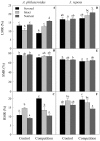An invasive clonal plant benefits from clonal integration more than a co-occurring native plant in nutrient-patchy and competitive environments
- PMID: 24816849
- PMCID: PMC4016286
- DOI: 10.1371/journal.pone.0097246
An invasive clonal plant benefits from clonal integration more than a co-occurring native plant in nutrient-patchy and competitive environments
Abstract
Many notorious invasive plants are clonal, however, little is known about the different roles of clonal integration effects between invasive and native plants. Here, we hypothesize that clonal integration affect growth, photosynthetic performance, biomass allocation and thus competitive ability of invasive and native clonal plants, and invasive clonal plants benefit from clonal integration more than co-occurring native plants in heterogeneous habitats. To test these hypotheses, two stoloniferous clonal plants, Alternanthera philoxeroides (invasive), Jussiaea repens (native) were studied in China. The apical parts of both species were grown either with or without neighboring vegetation and the basal parts without competitors were in nutrient- rich or -poor habitats, with stolon connections were either severed or kept intact. Competition significantly reduced growth and photosynthetic performance of the apical ramets in both species, but not the biomass of neighboring vegetation. Without competition, clonal integration greatly improved the growth and photosynthetic performance of both species, especially when the basal parts were in nutrient-rich habitats. When grown with neighboring vegetation, growth of J. repens and photosynthetic performance of both species were significantly enhanced by clonal integration with the basal parts in both nutrient-rich and -poor habitats, while growth and relative neighbor effect (RNE) of A. philoxeroides were greatly improved by clonal integration only when the basal parts were in nutrient-rich habitats. Moreover, clonal integration increased A. philoxeroides's biomass allocation to roots without competition, but decreased it with competition, especially when the basal ramets were in nutrient-rich sections. Effects of clonal integration on biomass allocation of J. repens was similar to that of A. philoxeroides but with less significance. These results supported our hypothesis that invasive clonal plants A. philoxeroides benefits from clonal integration more than co-occurring native J. repens, suggesting that the invasiveness of A. philoxeroides may be closely related to clonal integration in heterogeneous environments.
Conflict of interest statement
Figures





References
-
- Alpert P, Mooney HA (1986) Resource sharing among ramets in the clonal herb, Fragaria chiloensis . Oecologia 70: 227–233. - PubMed
-
- Stuefer JF, Kroon HD, During HJ (1996) Exploitation of environmental heterogeneity by spatial division of labor in a clonal plant. Funct Ecol 10: 328–334.
-
- Alpert P, Holzapfel C, Slonimski C (2003) Differences in performance between genotypes of Fragaria chiloensis with different degrees of resource sharing. J Ecol 91: 27–35.
-
- Maurer DA, Zedler JB (2002) Differential invasion of a wetland grass explained by tests of nutrients and light availability on establishment and clonal growth. Oecologia 131: 279–288. - PubMed
-
- Chidumayo EN (2006) Fitness implications of clonal integration and leaf dynamics in a stoloniferous herb, Nelsonia canescens (Lam.) Spreng (Nelsoniaceae). Evol Ecol 20: 59–73.
Publication types
MeSH terms
LinkOut - more resources
Full Text Sources
Other Literature Sources

